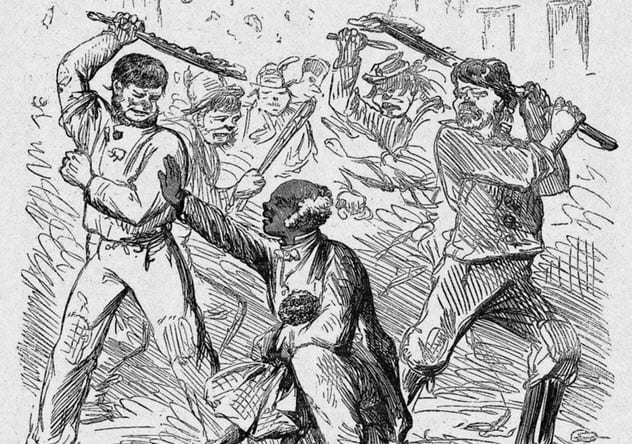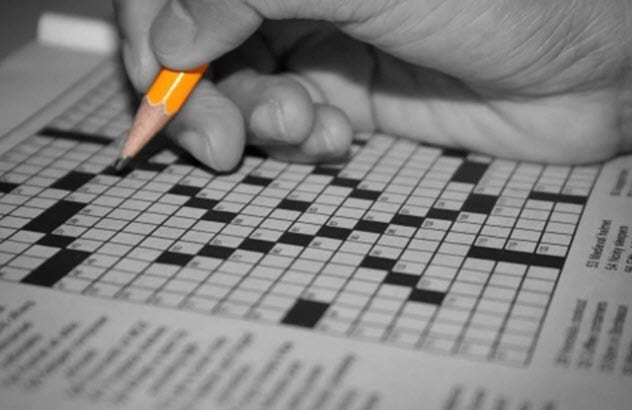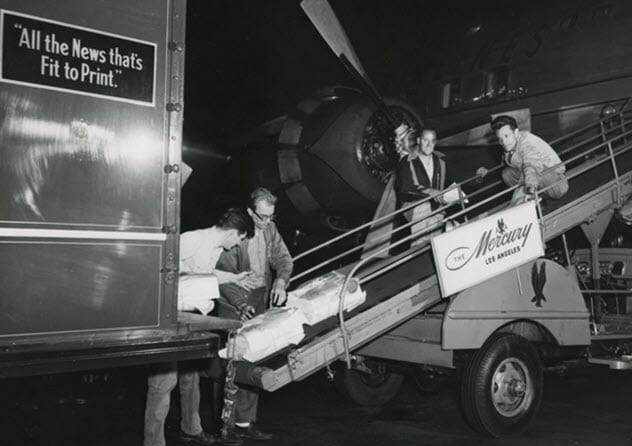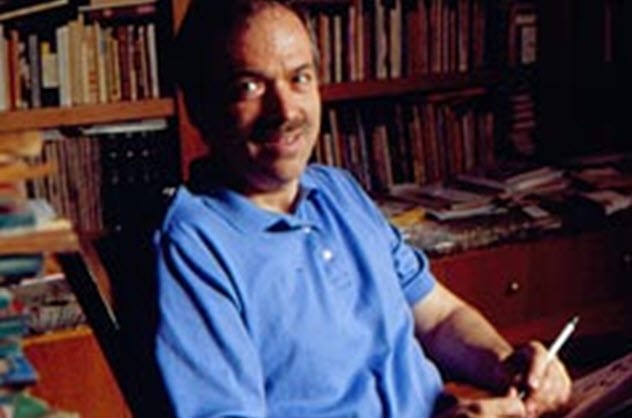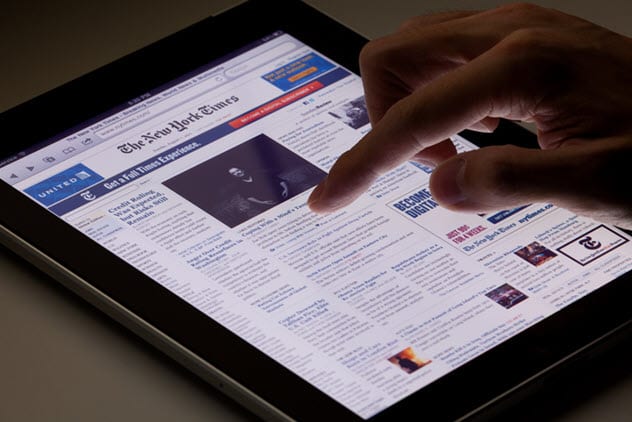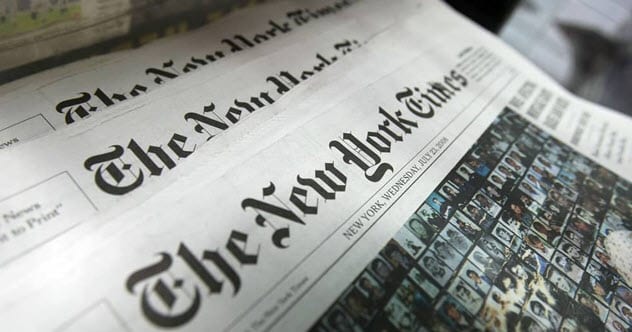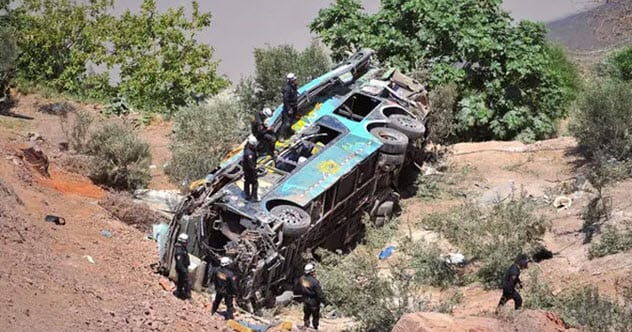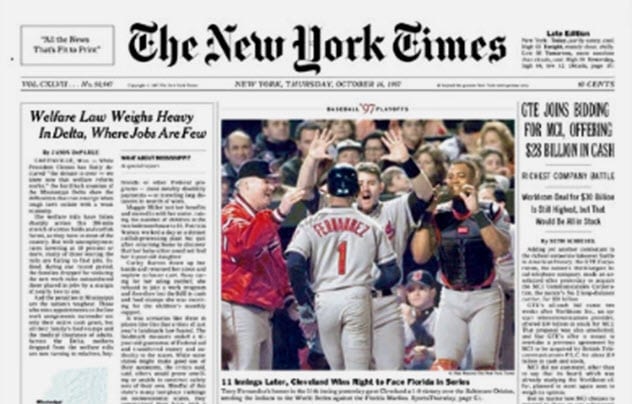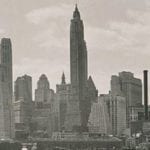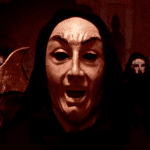The facts include everything from its humble beginnings to its famous crossword puzzle. Would you believe that The New York Times initially hated the puzzle and even called it a “a familiar form of madness”? Why did they reverse themselves on the puzzle, and why were they once so obsessed with bus plunges? The answers may surprise you.
10 The Founder Of The New York Times Warded Off Violent Protesters With A Gatling Gun
On July 13, 1863, violent demonstrators took over the streets of New York to protest the conscription law passed by the US Congress on March 3 of that year. The law permitted the Union to draft citizens into the army during the ongoing Civil War. It also allowed richer Americans to avoid conscription by paying $300. During the four-day protest, 119 people were killed, making it the deadliest riot in US history. Protesters looted shops, burned public and private properties, and destroyed train tracks and telegraph lines. They attacked and killed rich whites, free blacks, and anyone else who denounced slavery or supported the draft. The protesters also attacked and burned the offices of newspapers like The New York Times, which published articles denouncing slavery. However, The New York Times itself was spared when Henry Raymond, its founder and editor, installed two Gatling guns on top of his headquarters. The Gatling gun is a rapid-fire weapon that is considered the predecessor of the modern machine gun.[1] Raymond threatened to fire into the protesters if they got too close to his building. The 5,000-man strong crowd wisely retraced their steps and went on to attack the undefended New-York Daily Tribune instead. The New-York Daily Tribune said the charge was led by the young newsboys who delivered newspapers for the company. Some of the boys were around 12 years old.
9 The New York Times Once Condemned The Crossword Puzzle
The New York Times is famous for its crossword puzzles. Interestingly, it condemned the puzzle when the now-defunct New York World newspaper published the first crossword puzzle in 1913. The New York World crossword puzzle was created by journalist Arthur Wynne. It had a diamond shape, did not have black squares, and always appeared in Sunday editions of the newspaper. Most New York–based newspapers joined the fad and were all publishing puzzles by 1920 except, of course, The New York Times. The New York Times did not hide its disgust about the crossword puzzle. One of its columnists even wrote an article titled “A Familiar Form of Madness” just to criticize puzzles. The unnamed columnist wrote that crossword puzzles were “a primitive form of mental exercise and success or failure in any given attempt is equally irrelevant to mental development.” The writer added that puzzles were not a sport but something created to pass time. He also described it as a “sinful waste in the utterly futile finding of words, the letters of which will fit into a prearranged pattern, more or less complex.”[2] The New York Times changed its opinion about puzzles after Japan bombed Pearl Harbor on December 7, 1941. Lester Markel, the editor of the Sunday edition, informed his publisher that readers required something to relax from the deadly news of World War II. That “something” was the crossword puzzle. The New York Times published its first crossword puzzle on February 15, 1942, and has not looked back since.
8 The New York Times Tried To Change Its Slogan In 1896
When you see the slogan “All the News That’s Fit to Print,” you know you are dealing with The New York Times. However, that would have been a lot different if the newspaper had changed its slogan when it tried to do so in 1896. At the time, The New York Times was a dying newspaper and had been losing readers to its competitors. That started to change when Adolph S. Ochs acquired it from its former owners and tried bringing it to the forefront of American news. Ochs decided that the newspaper needed a new slogan. He organized a competition for a new slogan and asked readers to submit “a phrase of 10 words or less which shall more aptly express the distinguishing characteristics of The New York Times.” The winner would be rewarded with $100. People came up with cool slogans like “News, Not Nausea,” “Fresh Facts Free From Filth,” “Truth Without Trumpery,” and “Make Much of Me—Good Papers Are Scarce.” There was also “Sensible News for Sensible Folks,” “A Decent Newspaper for Decent People,” “Clean News for Clean People,” and “Honest News for Honest People.” Some compared the newspaper to food, giving us humorous taglines like “Choice Cuts From Life’s News Mart,” “Full of Meat, Clean and Neat,” “Treasures From Earth’s News Harvest,” “Bread of Sifted Wheat; News of Sifted Truth,” “The Wheat of News Threshed of Chaff,” and “What Is Good Luck? Three Square Meals and The Times.” Others submissions included “News Without Noise,” “All News When Fit, When Not We Wait a Bit,” “We Propose to Demonstrate That Journalism Is a Decent Profession,” “It’s Safe to Read The Times,” “Paper, Ink, Brains and Conscience,” “Brainy, Not Harebrained,” “A History of Today,” and “Cleanliness Is Honesty! Give Me a Bathtub and The New York Times.” There was also “Treats Honestly Every Topic Interesting Men Except Scandals,” “A Light in a Dark Place,” and “Out Heralds The Herald, Informs The World, Extinguishes The Sun.” The last one was directed at The Herald, The World, and The Sun, three other newspapers that competed with The New York Times. The winner was D.M. Redfield, who suggested “All the World’s News, but Not a School for Scandal.” Redfield received the $100 reward, but The New York Times added that they would not adopt his slogan. They would just stick with “All the News That’s Fit to Print.”[3]
7 The New York Times Considered A Different Slogan For Its Website
The New York Times considered using a separate slogan for its website in the 1990s. In Adolph S. Ochs’s fashion, it launched a competition offering a $100 reward to anyone who came up with the best slogan. The contest was announced on August 18, 1996—exactly 100 years after Ochs acquired the newspaper. The New York Times received over 8,000 entries by the time it was over. Some of the suggested entries included “News of the Land, Without Dirty Hands,” “The News of the Day, a Click Away,” “The Times @ Any Time,” “All the News That’s Fit to Print Out,” and “All the News That’s Fit to Click.”[4] The winners were 23 people who had suggested that the paper stick with “All the News That’s Fit to Print.” Dr. Fred A. Ringwald, one of the contestants, wrote about the old slogan: “It’s a splendid slogan and fits the mission of The New York Times, no matter what medium it comes in these days. Why do you need a new one?” Richard Olsen, another participant, wrote, “Keep ‘All the News That’s Fit to Print.’ That’s The Times. Enough Said.” Nigel Euling suggested, “Don’t change it! If you do, history will judge you poorly.” Karen Pike Davis asked, “Why tamper with genius? The slogan says it all and has been saying it for 100 years. Why change now?”
6 Its Crossword Puzzle Editor Has The World’s Only College Degree In Enigmatology
Will Shortz has been the editor of The New York Times crossword puzzle since 1993. He became fascinated by puzzles as a child when he received his first crossword puzzle from his mother. Later, he started making his own puzzles and sold the first one when he was 14. When he was older, Shortz decided to step things up a bit by studying enigmatology, the analysis of puzzles, in college. Although no school offered that course of study, he got the degree when Indiana University allowed him to create a major in enigmatology. As far as he knows, Shortz remains the only human with a degree in enigmatology. He also has a degree in law from the University of Virginia.[5]
5 The Internet Forced It To Reduce The Size Of Its Newspapers
Several newspapers reduced the size of their print papers as they tried to cut costs after readers turned to the Internet for their news. As advertisers followed the audience to the Internet, it hit the finances of many newspapers across the US. The New York Times held on and did not reduce the size of its paper until April 2008.[6] In 2006, The New York Times revealed that it would be making its newspapers 3.8 centimeters (1.5 in) smaller in two years’ time. That was around 5 percent of the space it used for reporting the news. The company also announced that it would be closing down its printing operation in Edison, New Jersey, leading to the loss of 250 jobs.
4 BuzzFeed Once Borrowed Its Slogan
In 2017, BuzzFeed created a new morning show, AM to DM, which it aired live on Twitter. The show’s slogan was “All the News Too Lit for Print.” This was clearly a pun on “All the News That’s Fit to Print,” which The New York Times had trademarked in 1996. BuzzFeed did not deny that it had borrowed The New York Times‘s slogan. Shani O. Hilton, who was in charge of BuzzFeed’s US news division, had included “with apologies to the Gray Lady” in a blog post she wrote about the show and the slogan. BuzzFeed later changed its slogan after The New York Times got its attorneys involved. The viral site did not give up without some drama, though. Its spokesperson Matt Mittenthal said, “We’re glad The Times is following along with our new show, like the rest of our robust audience.”[7]
3 Why It Was Fond Of Bus Plunges
Anyone who has read traditional print newspapers has observed that the papers rarely use words like “fall” or “plummet” to describe buses that fall off bridges, mountainsides, or whatever. They use “plunge” instead. Why do buses plunge and not fall or plummet? “Bus plunge” stories first appeared in the 1900s when newspapers required brief stories to fill blank spaces. These stories, called fillers, could be “K-heds” or plunge stories. K-heds were often irrelevant one-sentence news items. One K-hed that appeared in a 1950s edition of The New York Times was: “Most snails are both male and female, according to the Associated Press.” Plunging buses were longer than K-heds. A regular bus plunge story went: “Eight persons perished today when a small bus plunged over a [91-meter (300 ft)] cliff into the sea near the town of Mogan. One man jumped from the vehicle before it reached the edge and was saved. All the victims were Spaniards.”[8] Like other bus plunge stories, the news item above was arranged from the most important to the least important. That way, editors could remove entire sentences if they required something shorter. Newspapers also preferred countries with shorter names like Peru or Spain instead of Argentina. The New York Times was fonder of bus plunge stories than other newspapers of the day. However, like the others, The New York Times stopped publishing filler and bus plunge stories when they switched to using software to lay out their newspapers in the 1980s and 1990s.
2 It Refused To Join The Color Printing Bandwagon—At First
The New York Times was one of the last US newspapers to start printing in color. This began in 1993 even though rival newspapers like USA Today had been publishing in color since 1982. The Book Review section was the first to use color with a green-and-orange snake, which was a test. The Times published it in that section of the paper because it was about books and not photos or colors. The editors believed that readers would not make much fuss if the color turned out badly. The front page first used color on October 16, 1997. The switch was surprising to staffers who thought that the paper would never adopt color printing. The New York Times actually wanted to print in color earlier. But they delayed because the process was still under development. Several newspapers printed in poor quality color at the time.[9]
1 The New York Times Started The Famous Times Square Ball Drop
An electrified ball is dropped from the top of a flagpole in Times Square, New York, every New Year. The Times Square Ball Drop is so popular that about 1.2 billion people watch it these days. Police even stop traffic in the square from the afternoon of December 31. The event is organized by the Times Square Alliance. Interestingly, The New York Times created the event over a century ago to promote their new headquarters, which was right in the square. The area was called Longacre Square at the time but was renamed Times Square in 1905.[10] The New York Times had the first ball drop on New Year’s Day 1905. During the morning of December 31, 1904, the paper published an advertisement on its front page that asked people to come view its new building at midnight. The square was filled with people by 9:00 PM. Interestingly, the original event did not involve a ball but lots of fireworks instead. A controlled dynamite explosion at midnight made the building look like it was on fire. People returned to watch the event the following year, and the tradition has continued ever since. The New York Times used fireworks until 1907 when it dropped the first electrified ball.
